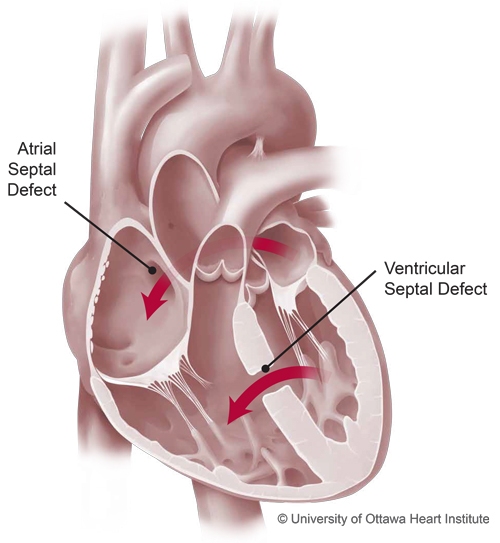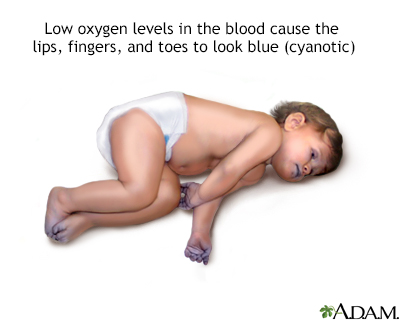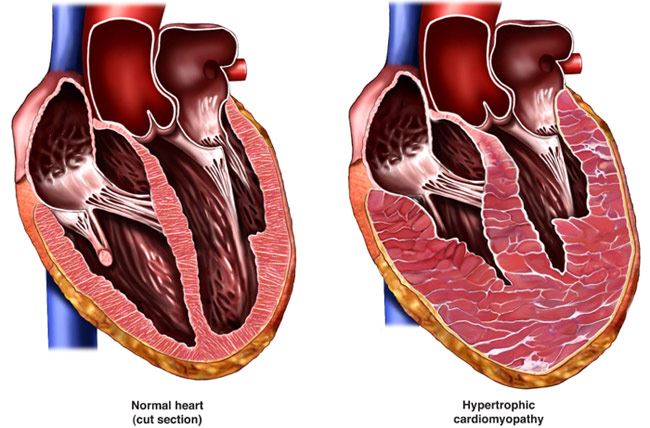Congenital heart defects are a significant concern for parents and medical professionals alike. These defects can range from mild to severe and can have a profound impact on a child's quality of life. One of the most common types of congenital heart defects is a hole in the heart, which affects approximately 1 in 100 children.
This condition occurs when there is an abnormal opening in the wall of the heart, allowing blood to flow between the heart's chambers. The hole can be present in various locations, including the septum, which is the wall of tissue that separates the heart's chambers. The presence of a hole in the heart can lead to various complications, including respiratory problems, fatigue, and an increased risk of infections.
The causes of congenital heart defects, including a hole in the heart, are not fully understood. However, research suggests that a combination of genetic and environmental factors may contribute to the development of these defects. Some of the potential risk factors include:
- Family history of congenital heart defects
- Maternal diabetes or obesity
- Exposure to certain medications or substances during pregnancy
- Genetic syndromes, such as Down syndrome
Early detection and treatment of congenital heart defects are crucial to preventing long-term complications and improving outcomes for affected children. Diagnosis typically involves a combination of physical examinations, imaging tests, and other diagnostic procedures. Treatment options vary depending on the severity and location of the hole, and may include medication, surgery, or catheter-based interventions.
Raising awareness about congenital heart defects, including a hole in the heart, is essential to promoting early detection and treatment. By educating parents, healthcare providers, and the general public about the signs and symptoms of these defects, we can work together to improve the lives of children affected by these conditions. This introduction aims to provide a comprehensive overview of congenital heart defects, with a focus on raising awareness and promoting education about these important health issues.

What is a Hole in the Heart?
A hole in the heart, also known as a congenital heart defect, is a condition where there is an abnormal opening in the wall between the heart's chambers. This opening can occur in various parts of the heart, including the septum, which is the wall of tissue that separates the heart's chambers.
The size of the hole can vary greatly, ranging from a small hole to a large one. In some cases, the hole may be so small that it does not cause any significant problems, while in other cases, it can be large enough to cause serious complications. The size of the hole will often determine the severity of the symptoms and the treatment options available.
The causes of a hole in the heart are often unclear, but it is thought to occur during fetal development when the heart is forming. In some cases, it may be caused by genetic factors or environmental factors, such as the mother's diet or exposure to certain substances during pregnancy.
Some common types of holes in the heart include:
- Atrial septal defect (ASD), which is a hole in the wall between the upper chambers of the heart
- Ventricular septal defect (VSD), which is a hole in the wall between the lower chambers of the heart
In some cases, a hole in the heart may close on its own, especially if it is small. However, in many cases, surgical intervention is required to close the hole and prevent further complications. The treatment options will depend on the size and location of the hole, as well as the overall health of the individual. In general, the goal of treatment is to close the hole and restore normal blood flow through the heart.
Surgical intervention may involve open-heart surgery or a minimally invasive procedure, depending on the specific condition and the individual's needs. In some cases, medication may be used to manage symptoms and prevent complications, while the individual waits for surgery or to see if the hole will close on its own. With proper treatment, many individuals with a hole in the heart are able to lead normal, active lives.

Symptoms of a Hole in the Heart
A hole in the heart, also known as a congenital heart defect, can exhibit a range of symptoms, particularly in infants and children. One of the primary indicators of this condition is rapid breathing. This occurs because the heart is working harder to pump blood, leading to increased respiratory rates. As a result, children with a hole in the heart may breathe faster than normal, even when they are at rest.
Poor weight gain is another symptom that may be observed in children with a hole in the heart. This can happen because the body is diverting more energy to support the heart's increased workload, leaving fewer resources for growth and development. Additionally, fatigue is a common symptom, as the heart's reduced efficiency can lead to decreased oxygen delivery to the body's tissues.
In some cases, children may experience cyanosis, which is a bluish discoloration of the skin. This occurs when there is a significant amount of deoxygenated blood being circulated, often due to the mixing of oxygenated and deoxygenated blood in the heart. Some common signs of cyanosis include:
- Bluish discoloration of the lips, fingers, and toes
- Shortness of breath or difficulty breathing
- Poor appetite and difficulty feeding
These symptoms can vary in severity and may be more pronounced during periods of physical activity or when the child is crying or feeding.
It is essential to note that some children with a hole in the heart may not exhibit any noticeable symptoms, especially if the defect is small. However, as the child grows and develops, symptoms may become more apparent, highlighting the importance of regular check-ups with a pediatrician to monitor the child's health and detect any potential issues early on.

Causes and Risk Factors
The exact cause of a hole in the heart is not always known, but research suggests that it is often related to a combination of genetic and environmental factors. This complex interplay can affect the development of the heart during fetal formation, leading to defects such as holes in the heart. Understanding these factors can provide valuable insights into the origins of this condition.
Genetic factors are thought to play a significant role in the development of heart defects. If there is a family history of heart defects, the risk of a child being born with a hole in the heart increases. This suggests that certain genetic mutations or inherited traits can predispose individuals to heart defects.
Environmental factors during pregnancy can also contribute to the development of heart defects. For instance, maternal diabetes has been linked to an increased risk of heart defects in newborns. Additionally, certain infections during pregnancy can affect the development of the fetus's heart, leading to defects such as holes in the heart.
Some of the key risk factors for a hole in the heart include:
- Family history of heart defects: Having a family history of heart defects increases the risk of a child being born with a hole in the heart.
- Maternal diabetes: Women with diabetes during pregnancy are at a higher risk of having a child with a heart defect.
- Certain infections during pregnancy: Infections such as rubella can increase the risk of heart defects in newborns.
These risk factors highlight the importance of proper prenatal care and management of any underlying medical conditions during pregnancy to minimize the risk of heart defects in newborns.

Treatment and Management
When it comes to addressing heart-related issues, the approach to treatment and management can vary greatly depending on the specific condition and its severity. Treatment options are designed to alleviate symptoms, prevent complications, and improve the quality of life for the individual.
Medication is often one of the first lines of treatment, aiming to manage symptoms and slow the progression of the condition. This can include a variety of drugs that help to reduce blood pressure, prevent blood clots, or improve heart function.
In addition to medication, catheter-based procedures offer a less invasive alternative to traditional surgery. These procedures involve using a catheter to perform interventions within the heart, such as closing holes or opening blocked arteries. This approach can reduce recovery time and minimize the risk of complications.
For more severe cases, surgery may be necessary. This could involve open-heart surgery to repair or replace damaged heart valves, close holes, or bypass blocked arteries. The decision to undergo surgery is typically made after careful consideration and consultation with a healthcare provider.
In some instances, a hole in the heart may not require immediate treatment. This is often the case with small atrial septal defects (ASDs) or ventricular septal defects (VSDs), which may close on their own or not cause significant symptoms. However, regular monitoring is crucial to prevent potential complications. This can include:
- Regular check-ups with a cardiologist to monitor heart function and detect any changes
- Echocardiograms to visualize the heart and assess the size and impact of the hole
- Electrocardiograms (ECGs) to monitor heart rhythm and detect any abnormalities
- Lifestyle modifications, such as avoiding strenuous activities or managing stress, to reduce the risk of complications
Regular monitoring allows healthcare providers to promptly identify any changes or complications, ensuring timely intervention and preventing long-term damage. By working closely with a healthcare team, individuals can effectively manage their condition and maintain optimal heart health.

Frequently Asked Questions (FAQ)
What are the chances of a hole in the heart closing on its own?
The likelihood of a hole in the heart closing on its own depends on various factors. The size and location of the hole play a significant role in determining the chances of spontaneous closure. Small holes, typically less than 3mm in diameter, are more likely to close on their own compared to larger holes.
The location of the hole is also an important factor. Holes located in the atrial septum, which is the wall between the heart's upper chambers, are more likely to close spontaneously than those located in the ventricular septum, which is the wall between the heart's lower chambers.
Some key factors that influence the likelihood of a hole in the heart closing on its own include:
- Size of the hole: smaller holes are more likely to close
- Location of the hole: holes in the atrial septum are more likely to close
- Child's overall health: children with good overall health are more likely to experience spontaneous closure
- Presence of other heart defects: children with other heart defects may be less likely to experience spontaneous closure
The child's overall health also plays a crucial role in the likelihood of spontaneous closure. Children who are otherwise healthy and do not have other heart defects or medical conditions are more likely to experience closure of the hole on their own. In contrast, children with other heart defects or medical conditions may be less likely to experience spontaneous closure and may require surgical or catheter-based intervention to close the hole.
In general, the chances of a hole in the heart closing on its own are higher in younger children. As the child gets older, the likelihood of spontaneous closure decreases, and surgical or catheter-based intervention may be necessary to close the hole. Regular monitoring by a pediatric cardiologist is essential to determine the best course of treatment for a child with a hole in the heart.
Can a hole in the heart be prevented?
Maintaining a healthy lifestyle during pregnancy is crucial in reducing the risk of congenital heart defects, including a hole in the heart. This can be achieved by eating a balanced diet, staying hydrated, and engaging in regular exercise. A well-nourished mother is less likely to have a child with birth defects, as a healthy diet provides essential nutrients for fetal development.
Certain risk factors can increase the likelihood of a hole in the heart, and avoiding these can help reduce the risk. Some of these risk factors include:
- Family history of congenital heart defects
- Diabetes and other medical conditions
- Smoking and alcohol consumption during pregnancy
- Certain medications and environmental toxins
By being aware of these risk factors, expectant mothers can take steps to minimize their exposure and reduce the likelihood of their child developing a hole in the heart.
Prenatal care is also essential in preventing congenital heart defects. Regular check-ups with a healthcare provider can help identify any potential issues early on, allowing for prompt treatment and reducing the risk of complications. Additionally, prenatal testing such as ultrasounds and echocardiograms can help detect congenital heart defects, including a hole in the heart, and enable healthcare providers to develop a plan for treatment and management.
While some cases of congenital heart defects may not be preventable, taking proactive steps to maintain a healthy lifestyle and avoid certain risk factors can significantly reduce the likelihood of a hole in the heart. By prioritizing prenatal care and being mindful of potential risk factors, expectant mothers can help ensure the best possible outcome for their child's health.
What is the long-term outlook for children with a hole in the heart?
Children with a hole in the heart, also known as a congenital heart defect, can have a varied prognosis depending on the size and location of the hole, as well as the overall health of the child. However, with advances in medical technology and treatment options, the outlook for these children has improved significantly.
In general, children with a small hole in the heart may not require any treatment at all, as the hole may close on its own. For those with larger holes, surgical intervention may be necessary to repair or close the defect. The goal of treatment is to alleviate symptoms, prevent complications, and improve the child's quality of life.
With proper treatment and management, most children with a hole in the heart can lead active and healthy lives. They may need to make some lifestyle adjustments, such as avoiding certain activities or taking medication to prevent complications. Ongoing monitoring and follow-up care are crucial to ensure that the child's condition is stable and to address any potential issues promptly.
Some of the key factors that influence the long-term outlook for children with a hole in the heart include:
- Size and location of the hole
- Presence of other heart defects or health conditions
- Effectiveness of treatment and management
- Adherence to follow-up care and monitoring
- Overall health and well-being of the child
As children with a hole in the heart grow and develop, they may need to adapt to certain limitations and precautions. For example, they may need to avoid contact sports or other activities that could put excessive strain on the heart. Regular check-ups with a cardiologist and other healthcare professionals can help identify any potential issues and ensure that the child receives the necessary care and support.
In terms of long-term health implications, children with a hole in the heart may be at increased risk for certain complications, such as endocarditis or arrhythmias. However, with proper treatment and management, these risks can be minimized, and most children can lead full and active lives. By working closely with healthcare providers and following recommended treatment and management plans, children with a hole in the heart can thrive and reach their full potential.




